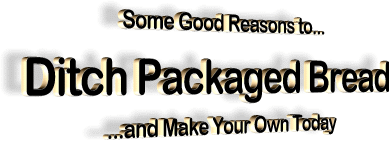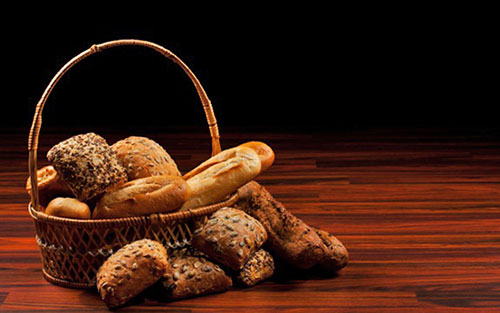For all you gluten-intolerant folks out
there, I apologize in advance, because this whole article is on
bread.
Though I try to eat organic wheat, barley, spelt, and
other grains in my bread, instead of genetically altered and
highly processed 'wheat' bread that is really nothing more than
the wheat shaft stripped of all its nutrition, I LOVE warm bread
straight from an oven.
Though you won't always be able to make
your own for convenience' sake, baking bread yourself instead of
buying it at a supermarket might be more appealing to you after
you read some of the 'interesting'
ingredients that end up in your favorite store-bought
loaves.
Many packaged breads and baked goods you see at your grocery
store look appetizing. They may even have labels on them that
say 'all natural, ' or the brand name itself will deceive you by
adulterating the name of Mother Nature, calling themselves
'Nature's Best' or something of that ilk.
But, guess again - I'm
sure Mother Nature didn't intend for the following 3
ingredients to be in something you dine on regularly:
1. L-Cysteine
L-Cysteine is a non-essential amino acid that the food
manufacturing business uses to change the texture of breads and
baked goods.
It is processed from dissolved human hair (from
China usually), duck
feathers, or hog hair. What's more, food makers are turning
away from a vegetable-derived L-Cysteine made in a fermentation
process to duck feathers, human hair, and hog feathers more often
because they can't appeal to customers wanting 'non-synthetic'
ingredients - or so they claim.
The last time I found a hair in my food at a restaurant I
sent my food back. Wouldn't you send back your packaged breads
if you knew they contained this ingredient?
2. High Fructose Corn Syrup
Food manufacturer's love to use this ingredient in our foods
- because it
is addictive, really easy to hide in breads and baked good,
and because HFCS is easier to transport and more economical in
countries where the price of sugar are twice the global price,
such as the United States and Canada.
The syrup can be 20 to 70
percent
less expensive than sugar:
Cheap for food makers, toxic to
consumers.
High fructose corn syrup is linked to a higher incidence of
Diabetes type II and obesity, with researchers at University
of Oxford and The University of California (High
fructose corn syrup and diabetes prevalence - A global
perspective) linking 20%
more of populations in any country that uses HFCS with Diabetes.
One study
performed by Princeton found that high-fructose corn syrup
ingestion in rats prompted considerably more weight gain than
table sugar - even when caloric intake was the same - and guess
what - obese people eat more HFCS, just what Big Food
manufacturer's want.
It can even alter the human metabolism almost permanently,
causing someone who normally easily maintains a healthy body
weight to become
overweight quite easily.
In another study, presented by
Natural Society's Anthony Gucciardi, he describes how much of
the commercial HFCS
contains mercury.
3. Azodicarbonamide
Had some respiratory issues lately? How about asthma or skin
irritations you can't explain?
Well, Azodicarbonamide,
found in many breads sold in grocery stores (some made by
very trusted brands), is a toxic chemical that Subway was
petitioned into removing from their breads because it shows
up in yoga mats and other plastics.
The Center for Science in the Public Interest explains
that when ADA is baked, it undergoes changes that could make
it even more dangerous. When baked, ADA forms semicarbazide and
urethane -
both of which have been linked to cancer in
mice.
Now compare these toxic ingredients, along with,
...with the ingredient list of most homemade
breads:
-
Salt
-
Organic Flour (of any kind, wheat, soy, barley, spelt,
amaranth, and many more)
-
Butter
-
Olive Oil
-
Free Range, Organic Eggs
-
Yeast
-
Filtered Water
-
Milk (organic, cow's milk, goat's milk, almond, hemp,
etc.)
Many breads don't take any time at all to prepare, even if
they are yeast-based and have to rise.
You could whip up a batch
of bread dough and let it rise while preparing dinner or having
some family quality time, and pop it in the oven a few hours
later to enjoy fresh, non-GMO, non-toxic goodness in as little
as 20 minutes.
Or, of course you can keep eating the list of ingredients
above, or pay the high cost of many organic and truly healthful
breads. Some sell for as much as $10 a loaf, while those made at
home can cost as little as $1 a loaf - and they sure taste a
whole lot better.
Even if you've never baked your own homemade bread, you can
start with one of these
three simple beginner recipes. You could even bake these
breads with your four-year-old - it is that easy.
For
bread-making connoisseurs, try these elaborate braided
breads, or these healthful
vegetable bread recipes, made with everything from delicious
Kalamata olives, to pumpkin, carrots, cinnamon, garlic, cloves,
or zucchini, among other delectable ingredients.
No more toxic bread!

